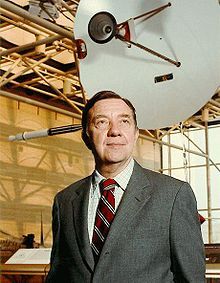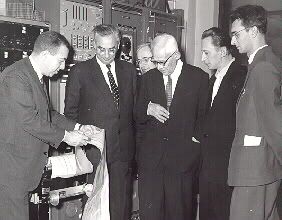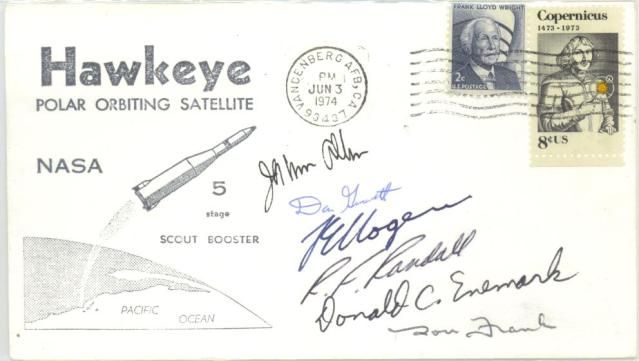Space Autograph of the Week Topic 5: James Van AllenOn September 7, 1914 Dr. James Van Allen was born in Mount Pleasant, Iowa. Van Allen would never stray far from Iowa as he was associated with the University of Iowa for a large portion of his life.

In 1940 Van Allen was a staff physicist for the Department of Terrestrial Magnetism of the Carnegie Institution in Washington, D.C where he acquired his interest in cosmic rays. After serving in the US Navy during World War II as an assistant gunnery officer Van Allen would do research at the Applied Physics Laboratory (APL) at John Hopkins University. Little know is that Van Allen not only worked on scientific space experiments but also had a large impact on the development of early sounding rockets.
At APL he organized and directed a team to conduct high-altitude experiments, using V-2 rockets captured from the Germans at the end of World War II. In late 1947 Van Allen would be elected chairman of the V-2 Upper Atmosphere Panel. The panel, under various names, would be in existence until May 1960
In the late 1940s, Van Allen decided a small sounding rocket was needed for upper atmosphere research and the Aerojet WAC Corporal and the Bumblebee missile were developed under a US Navy program. He also drew up specifications for the Aerobee sounding rocket which also became a production sounding rocket. In 1949 during the Aerobee rocket firing cruise of the U.S.S. Norton Sound Van Allen was part of a team that developed the idea for the Rockoon. This balloon-rocket combination would lift rockets on balloons high above most of Earth's atmosphere before firing them even higher. The rockets would be ignited after the balloons reached an altitude of 16 kilometers.
In 1951 Van Allen would become head of the Physics Department at the University of Iowa where he would strive to get his students interested in space studies. As TIME reported in 1959, "Van Allen's 'Rockoons' could not be fired in Iowa for fear that the spent rockets would strike an Iowan or his house." So Van Allen convinced the U.S. Coast Guard to let him fire his rockoons from the icebreaker Eastwind that was bound for Greenland [in 1952]. "The first balloon rose properly to 70,000 ft., but the rocket hanging under it did not fire. The second Rockoon behaved in the same maddening way. On the theory that extreme cold at high altitude might have stopped the clockwork supposed to ignite the rockets, Van Allen heated cans of orange juice, snuggled them into the third Rockoon's gondola, and wrapped the whole business in insulation. The rocket fired." In 1953 Rockoons fired off Newfoundland would detect the first hint of radiation belts surrounding Earth.
On September 26, 1957 a total of thirty-six Rockoons were launched from Navy icebreaker U.S.S. Glacier in Atlantic, Pacific, and Antarctic areas ranging from 75* N. to 72* S. latitude, as part of the U.S. International Geophysical Year scientific program headed by James A. Van Allen and Lawrence J. Cahill of The University of Iowa. These were the first known upper atmosphere rocket soundings in the Antarctic area. Launched from IGY Rockoon Launch Site 2, Atlantic Ocean; Latitude: 0.83* N, Longitude: 0.99* W.

Van Allen (center) with William Pickering and Wernher von Braun at an Explorer 1 news conference.
The first American satellite, Explorer 1, was launched into Earth's orbit January 31, 1959 on a Jupiter C missile from Cape Canaveral, Florida. Aboard were a micrometeorite detector and a cosmic ray experiment designed by Van Allen and his graduate students. Data from Explorer 1 and Explorer 3, launched March 26, 1958, were used by the Iowa group to make the first space-age scientific discovery: the existence of a doughnut-shaped region of charged particle radiation trapped by Earth's magnetic field. On December 6, 1958 Pioneer 3 launched aboard a Juno II rocket. The primary objective of the flight, to place a scientific payload in the vicinity of the moon failed but it did reach an altitude of 63,000 miles, providing Van Allen additional data that led to discovery of a second radiation belt. These belts are called the Van Allen Radiation Belts for his discovery of them.

Van Allen with Soviet scientists at 1959 International conference on cosmic radiation.
Van Allen, his colleagues, associates and students at The University of Iowa continued to fly scientific instruments on sounding rockets, Earth satellites (Explorer 52 / Hawkeye 1), and interplanetary spacecraft including the first missions (Pioneer program, Mariner program, Voyager program, Galileo spacecraft) to the planets Venus, Mars, Jupiter, Saturn, Uranus, and Neptune. Their discoveries contributed important segments to the world's knowledge of energetic particles, plasmas and radio waves throughout the solar system.

The cover shown is postmarked for the launch of Explorere 52/Hawkeye 1 from the University of Iowa. The satellite was designed, built, and tracked by personnel at the Department of Physics and Astronomy, University of Iowa whose sports teams are the Hawkeyes. The spacecraft was launched on June 3, 1974 into a polar orbit from Vandenberg Air Force base. The cover is signed and dated for the launch.
















